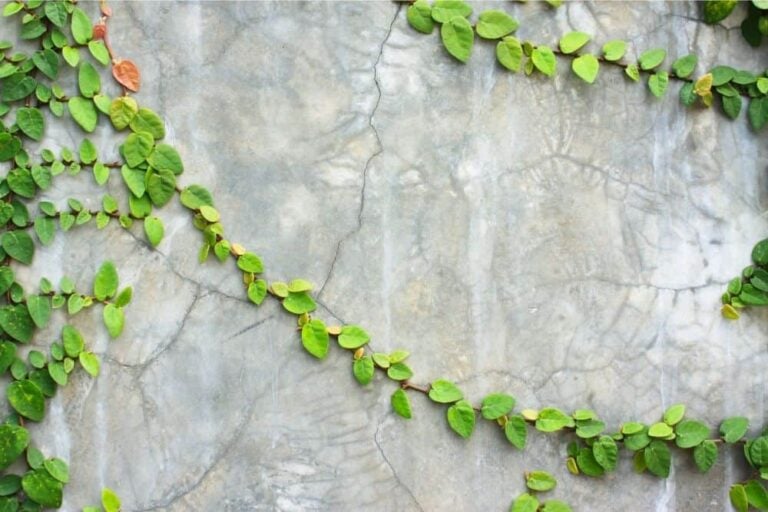19 Best Purple House Plants: The Ultimate Guide
Houseplants are undoubtedly one of the best ways to bring life and color to any home. With so many houseplants available in the world, you might be feeling overwhelmed by the sheer number of options available.
Do you want to go for a color scheme, or do you want an exotic indoor garden filled with plants within the same genus?
Green houseplants are the most common color, but if you’re looking to expand your plant knowledge and enhance your living space, you might want to find houseplants in a different color.
Thanks to the wonders of nature and hybridization, you can get houseplants in virtually any color – including purple!
Here is the ultimate guide to the 19 best purple house plants, including tips on how to keep these plants alive and thriving!
1. Wandering Jew (Tradescantia Zebrina)
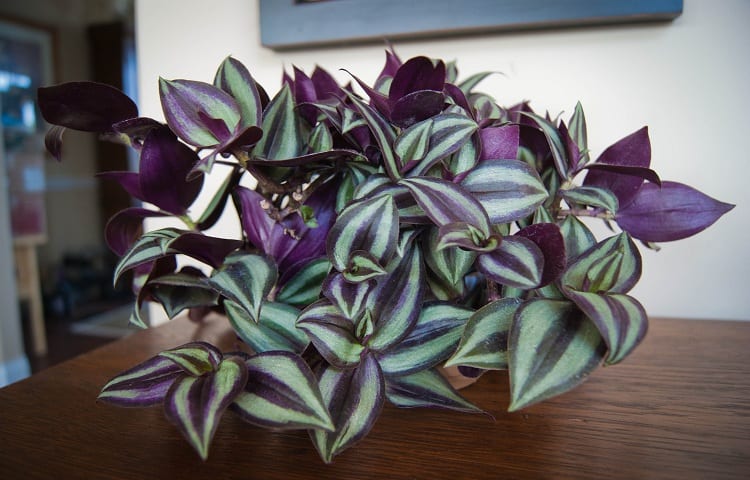
Also known as spiderwort or the inch plant, the Wandering Jew plant is known for its striped rich purple and green leaves.
There are several types of Tradescantia plants, all of which exhibiting uniquely patterned leaves, making them a fascinating species to own in a home.
These plants require a lot of care and watering in their early years, and it’s common for skin irritation to occur when animals or humans come into contact with the sap.
This is why Wandering Jew plants are often placed in hanging baskets.
- Family: Commelinaceae
- Native habitat: Central America
- Care: Low-maintenance
- Watering: Regularly
- Soil: High organic matter, well-draining
- Growth: Fast-growers, 6-12” in height and 24” in length
- Light: Bright and indirect sunlight
- Humidity: Average
- Temperature: 50-80 °F
- Common problems: Pests – spider mites, aphids, and fungus gnats
2. Persian Shield (Strobilanthes Dyeriana)
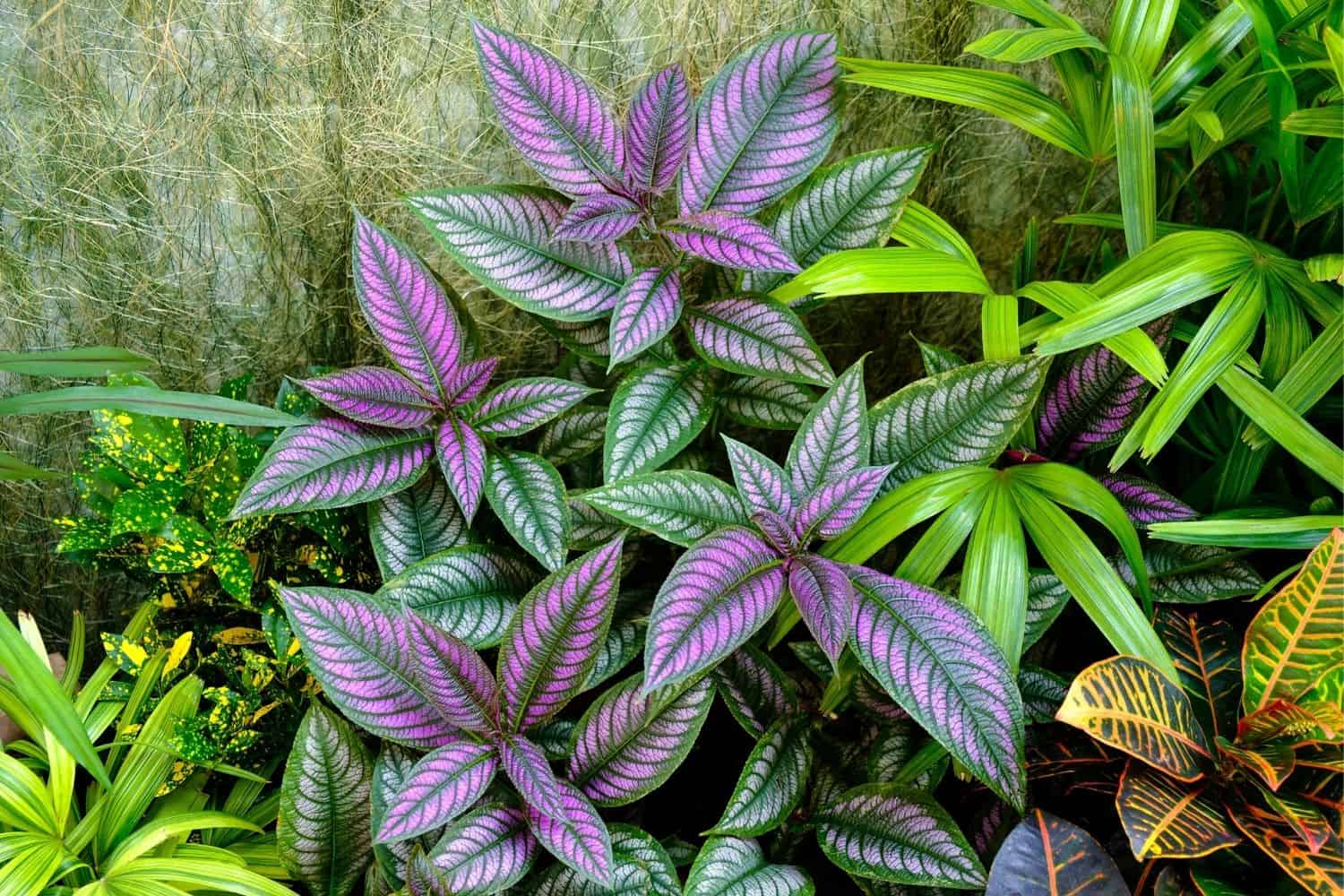
Also known as the royal purple plant, the Persian shield is a vivid tropical evergreen shrub that is most distinctive for its metallic and iridescent purple leaves with hints of green and silver, making the plant look something like a peacock.
This is one of the most popular purple houseplants and ornamental plants, and in the right conditions (particularly humid conditions), the plant is known to produce lavender-colored flowers.
As the plant grows older, and sometimes when it enters the dormancy period in winter, the bright colors will become duller.
- Family: Acanthaceae
- Native Habitat: Myanmar
- Care: Low-maintenance
- Watering: Regular (approximately once or twice a week)
- Soil: Acidic to neutral, well-draining, rich
- Growth: Grows to 3-4 feet tall
- Light: Partial shade
- Humidity: High
- Temperature: Above 60 °F
- Common problems: Fungus gnats and spider mites
3. Calathea Rattlesnake (Goeppertia Insignis)
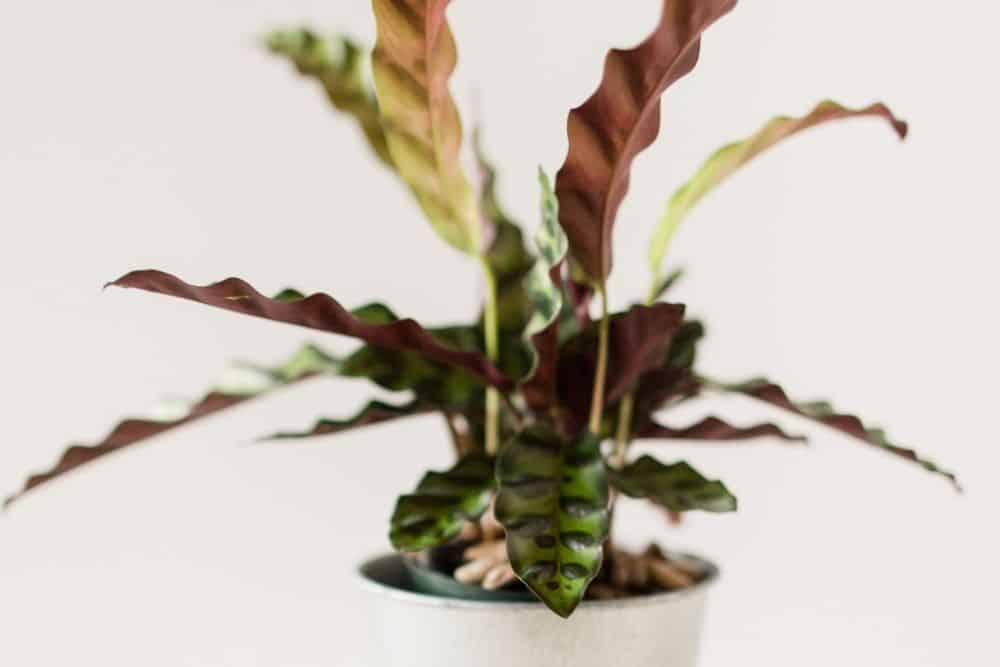
Simply known as the rattlesnake plant, calathea rattlesnake is an attractive plant that features light green leaves with rich purple undersides.
The pattern on the leaves is unique, with elongated darker green circles, giving the appearance of a leopard or snake markings.
Due to this fascinating coloring, the calathea rattlesnake is enjoyable to look at from all angles.
While this doesn’t tend to happen for indoor growing calathea rattlesnakes, they are known to produce small yellow flowers towards late spring in their native habitat.
These certainly aren’t the hardest plants to care for, but beginners may struggle with their requirements.
- Family: Marantaceae
- Native habitat: Brazil
- Care: Moderate maintenance
- Watering: Regular, less in winter
- Soil: Well-draining, peat moss and perlite
- Growth: Up to 30” tall
- Light: Medium to bright indirect sunlight
- Humidity: Moderate to high
- Temperature: 65-85 °F
- Common problems: Curling and dry leaves due to low humidity
4. Purple Oxalis (Oxalis Triangularis)
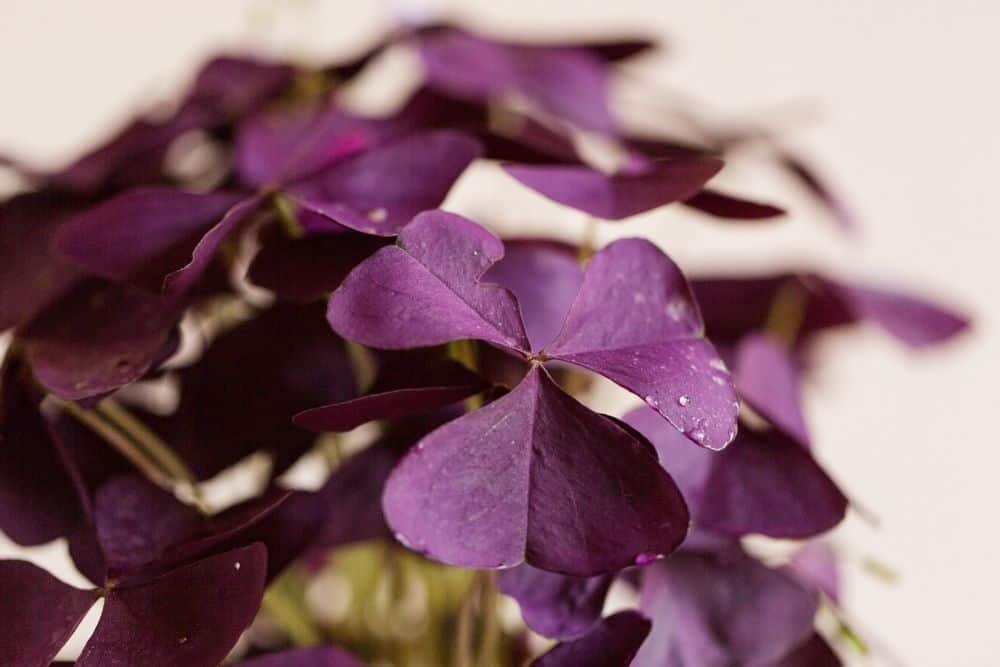
Purple oxalis is certainly one of the prettiest purple flowers on our list. These plants are also known as false shamrock for their triangle-shaped leaves that point towards each other in groups of three.
The leaves are often referred to as “butterflies” as they close up at night and in shaded conditions.
The purple oxalis is popular for its distinctive deep purple coloring, alongside the white, pale pink, or lavender-colored small flowers, making this a particularly delicate and pretty plant.
The plant’s unique movements according to light is another reason for its popularity.
- Family: Oxalidaceae
- Native habitat: Brazil
- Care: Low-maintenance
- Watering: Regular, enjoys even distribution of water
- Soil: Acidic, well-draining, sandy soil
- Growth: 1ft fall and 2ft wide
- Light: Partial shade
- Humidity: Moderate, misting required
- Temperature: 60-75 °F
- Common problems: White spots (sunburn) and powdery mildew
5. Ti Plant (Cordyline Fruticosa)
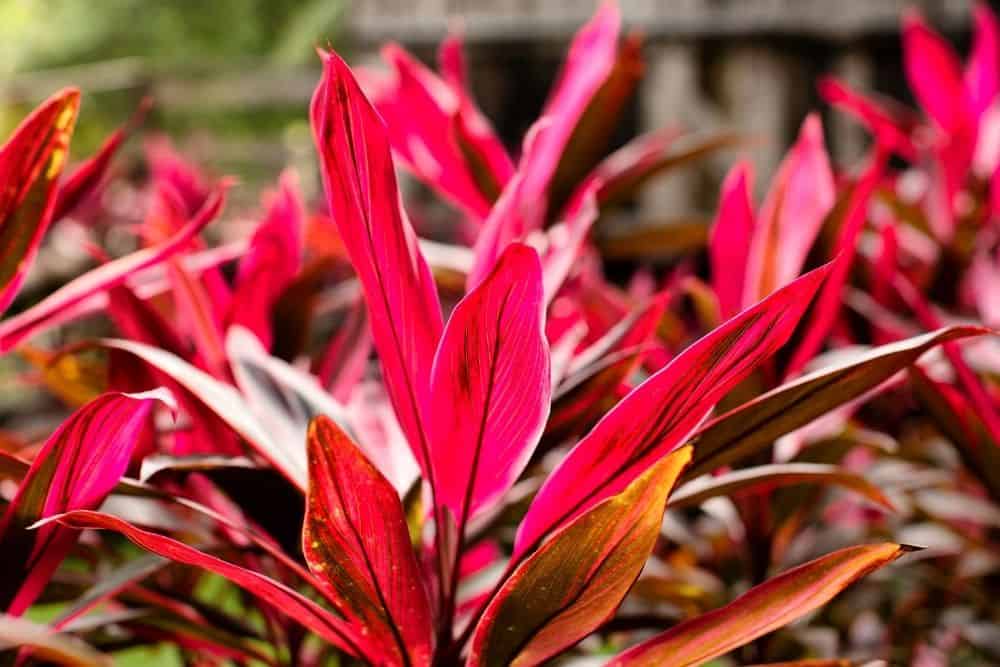
Known as the Hawaiian ti plant, palm lily, or cabbage plant, the ti plant is a classy purple plant that is believed to bring good luck.
These plants feature upright, long, and slender leaves in a mixture of bright purple, deep purple, and olive green colors, making for a unique statement piece in a room.
Not only are they beautiful, but the ti plant is also grown for medicinal and religious purposes in its native habitats.
According to Polynesian legend, the more stalks that appear on a ti plant, the more luck you have in good fortune.
- Family: Asparagaceae
- Native habitat: Southeast Asia, South Pacific, Papua New Guinea, New Zealand
- Care: Low-maintenance
- Watering: Little and often, avoid watering the leaves
- Soil: Well-draining, acidic
- Growth: Maximum of 10 ft tall and 3-4ft across
- Light: Partial sunlight
- Humidity: High
- Temperature: 65-95 °F
- Common problems: Leaf discoloration due to overwatering or too much sunlight
6. Echeveria
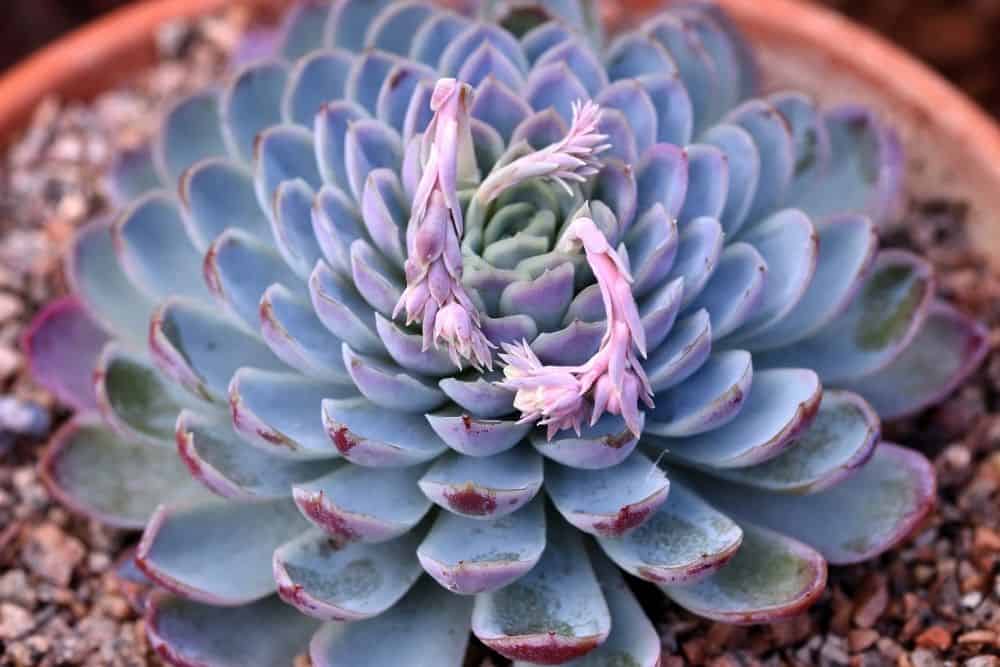
Echeveria is a genus of succulent plants that are best known for their stunning rose-like shapes.
There are over 150 species of this genus, and some of which offer a particularly breathtaking purple coloration – including Afterglow, Dark Prince, Purple Pearl, and Dark Moon.
It’s common for these purple varieties to exhibit purple edges to the thick succulent leaves, blending into a pale green color. The purple color ranges from a dusty lavender to deep and rich.
Succulents are notoriously easy to care for, so these purple plants are ideal for beginners!
- Family: Crassulaceae
- Native habitat: Central America
- Care: Low-maintenance
- Watering: Little and not often
- Soil: Well-draining standard cactus soil
- Growth: Size varies depending on species
- Light: Direct, bright sunlight
- Humidity: Low
- Temperature: Warm
- Common problems: Overwatering and underwatering
7. Prayer Plant (Maranta Leuconeura)
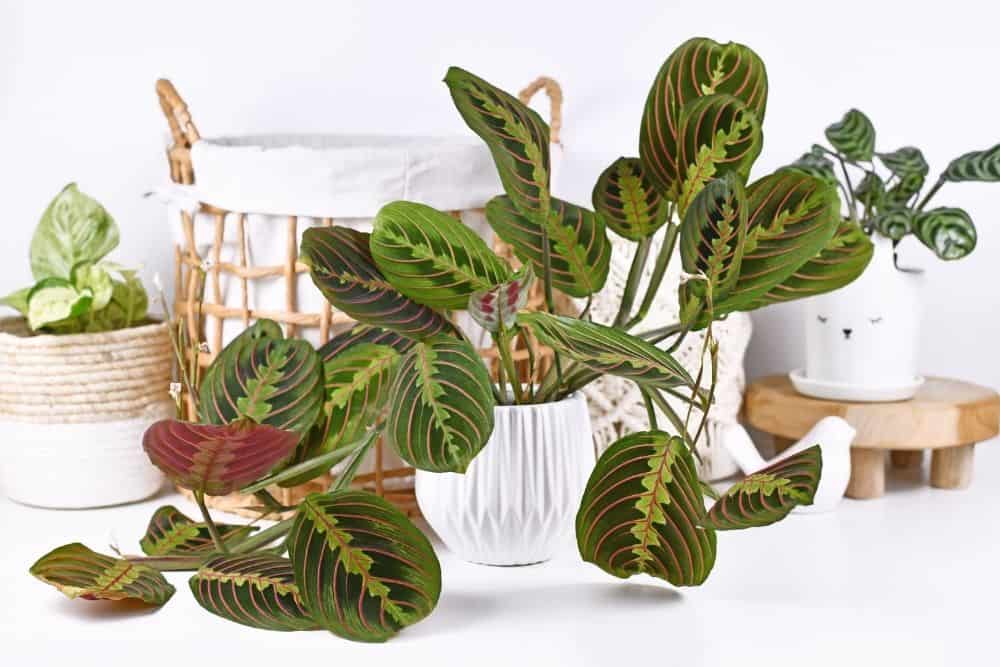
Prayer plants are undoubtedly one of the most popular types of houseplants in the world, and for good reason.
These plants get their name from their diurnal rhythm, which results in a unique movement wherein the leaves turn upright into a “praying” position at night.
If you’re lucky, you might be able to spot some of the leaves in action.
The reason why prayer plants are on this list is because of their distinctive coloring.
The upper parts of the leaves are variegated green, while the lower parts are a deep brownish purple. This means that when the plant is in its “praying” position, it looks mostly purple!
- Family: Marantaceae
- Native habitat: Brazil
- Care: Low to moderate maintenance
- Watering: Soil must stay moist in spring and summer with less watering in winter
- Soil: Well-draining, moist, neutral to acidic
- Growth: Slow-grower, reaches 12” or more in height depending on species
- Light: Indirect sun and shade
- Humidity: High
- Temperature: 65-85 °F
- Common problems: Leaf tips turn brown due to poor care
8. Rex Begonia (Begonia Rex-Cultorum)
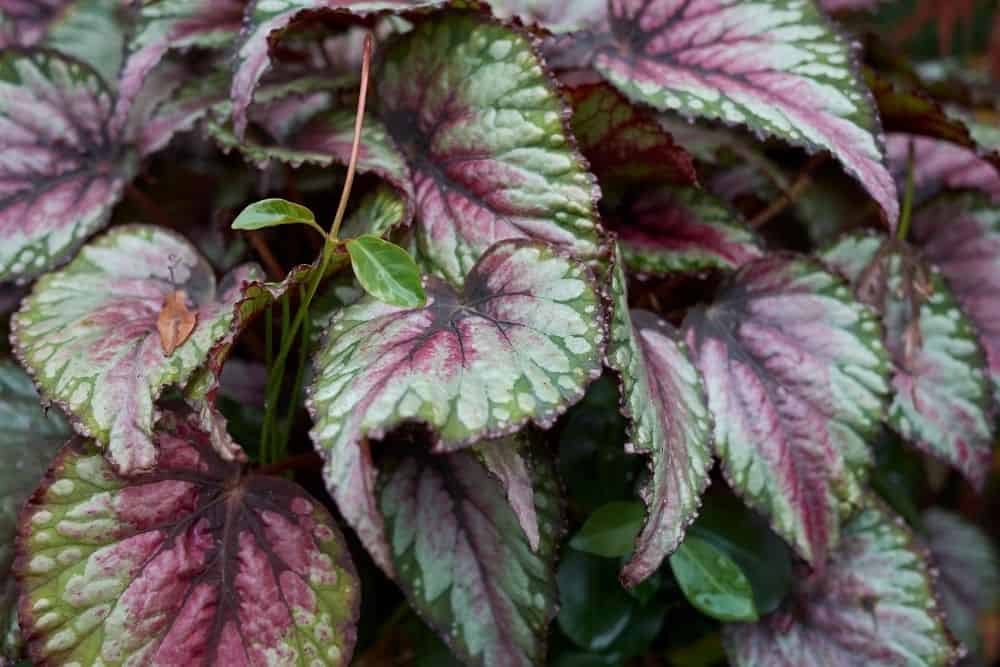
Also known as fancy-leaf begonias or painted-leaf begonias, rex begonias feature a spectrum of shapes, colors, and patterns.
You never quite know what you’re doing to get with these plants, because while some might be red or purple, others can be green or silver.
It’s also common to see streaks and patterns of other colors such as black, making for a striking appearance.
These plants are suitable for indoor and outdoor growing, and are more prone to flowering in outdoor conditions.
As the plants come in such a range of colors, make sure to buy one of these in person to make sure you get the ideal purple shade!
- Family: Begoniaceae
- Native habitat: Brazil
- Care: Moderate, pruning is necessary
- Watering: Regular watering for moist but not soggy soil
- Soil: Well-draining and porous
- Growth: 12-18” tall and wide
- Light: Partial indirect sunlight
- Humidity: 50%
- Temperature: 65-75 °F
- Common problems: Mealybugs and other pests
9. Purple Passion (Gynura Aurantiaca)
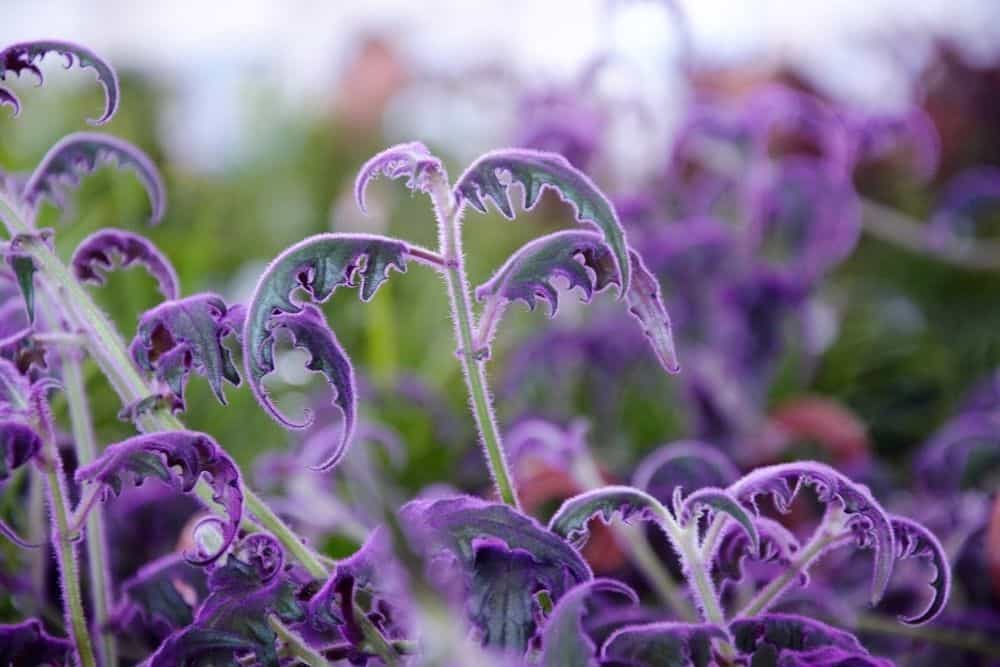
Either known as purple passion or the velvet plant, Gynura Aurantiaca is a particular stand-out species on our list.
This flowering plant is related to the daisy and is notorious for its green leaves coated with a layer of fuzzy purple hair with an electric purple outline to match.
In the sunlight, this purple is so vivid that it looks artificial.
As these plants grow like a vine when they mature, purple passion is most commonly kept indoors in hanging baskets to allow the stunning velvet-like leaves to float down.
The more sunlight they receive, the brighter the leaves are!
- Family: Asteraceae
- Native habitat: Southeast Asia
- Care: Low-maintenance
- Watering: Infrequently
- Soil: Well-draining and high in nutrients
- Growth: 1-2 ft
- Light: Bright and indirect or filtered sunlight
- Humidity: Moderate
- Temperature: 60-70 °F
- Common problems: Pests such as spidermites, aphids, and mealybugs
10. Greenovia Aurea / Purple Rose Succulent
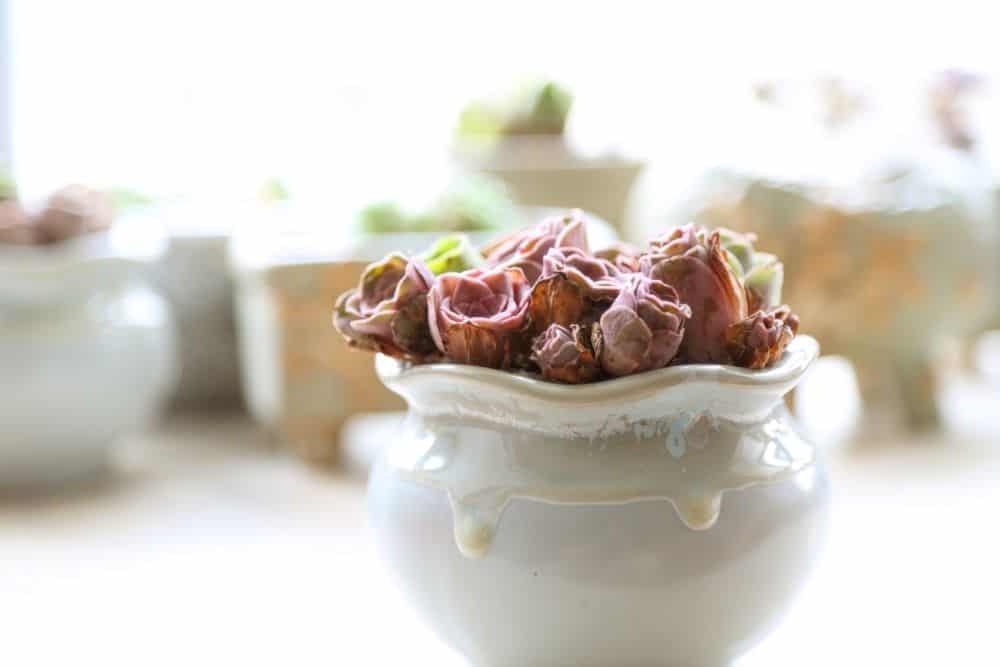
Greenovia refers to a group of rose-shaped succulent plants, with the greenovia aurea variant featuring a beautifully dusty purple coloring.
Also aptly known as the purple rose succulent, this plant is a must-have for succulent lovers, beginners, and anyone with an affinity to roses.
Unfortunately, due to their distinctive and unique beauty, these succulents are notoriously hard to find.
Even if you do get lucky, there is no guarantee that the succulent will be distinctly purple, as they often come in shades of pale green or pink, too.
- Family: Crassulaceae
- Native habitat: Canary Islands
- Care: Low-maintenance
- Watering: When top surface of soil is dry
- Soil: Fast-draining and sandy
- Growth: 6” in height
- Light: Bright direct or indirect sunlight
- Humidity: 40% average
- Temperature: Subtropical
- Common problems: Overwatering reduces color in leaves, and makes them turn yellow
11. Rubber Tree (Ficus Elastica)

With several nicknames (including Indian rubber bush, rubber fig, and rubber plant), the rubber tree is an astonishing houseplant to own.
Not only does this plant grow to towering 10-feet tall heights, but the leaves are notoriously rubber-like thanks to their waxy and thick texture.
When young, the leaves are reddish in color, before darkening into a purplish hue as they mature.
Despite their height, rubber trees can be made to be slow growers with proper care and limiting the size of their pots.
This means that if you’re looking for a good purple table plant that won’t take up the whole living space, this is a good plant for you.
- Family: Spurge
- Native habitat: Southeast Asia
- Care: Low-maintenance
- Watering: Weekly in spring and summer, then monthly in winter
- Soil: Well-draining and acidic
- Growth: 10-13 ft
- Light: Bright, indirect sunlight
- Humidity: Moderate to high, loves misting
- Temperature: 60-75 °F
- Common problems: If not contained, they can grow very fast
12. Moses-In-The-Cradle (Tradescantia Spathacea)
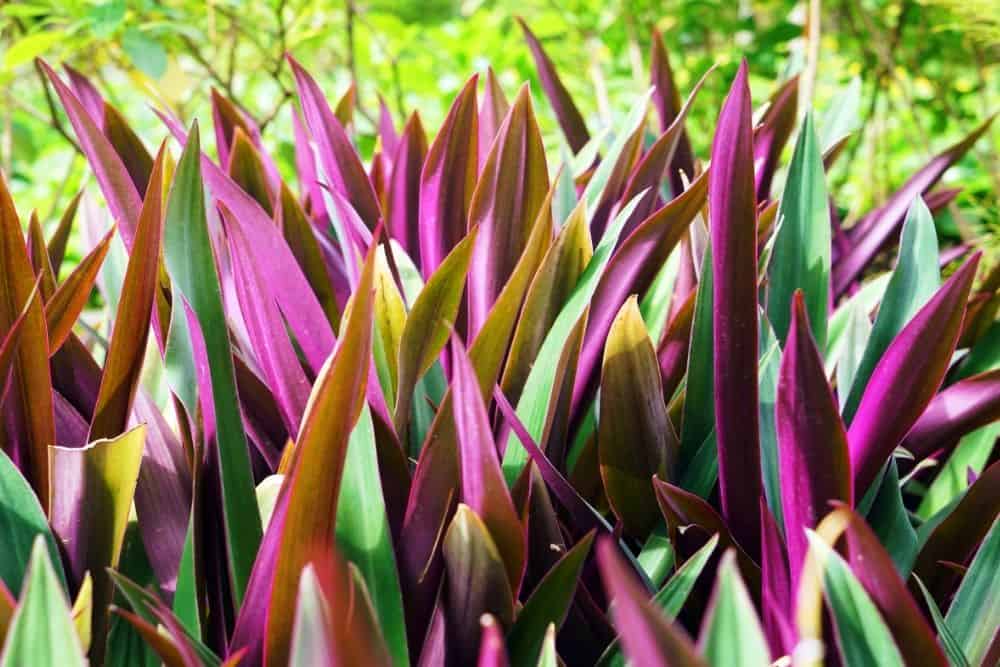
Also known as the boatlily, the Moses-in-the-cradle plant is a particularly astonishing plant. Interestingly, Moses-in-the-cradle is actually a herb!
This “herb” features rosettes of elongated, lance-shaped leaves that are predominantly green with white stripes on the top, and vibrant purple underneath.
When grown outdoors or in ideal conditions indoors, they will bloom in clusters of small white or pink flowers.
This plant is actually considered an invasive exotic species due to its abundance in Florida and Louisiana, so if you live in these states, you’ve probably got one growing in your backyard!
They are also popularly cultivated as an indoor houseplant.
- Family: Commelinaceae
- Native habitat: Guatemala, Belize, southern Mexico
- Care: Low-maintenance
- Watering: Regularly when the soil is dry
- Soil: Well-draining and porous
- Growth: 1-2 ft in height and diameter
- Light: Bright indirect sunlight
- Humidity: High
- Temperature: 60-85 °F
- Common problems: Scorched leaves from direct sunlight
13. Coleus Purple Plant (Plectranthus Scutellarioides)
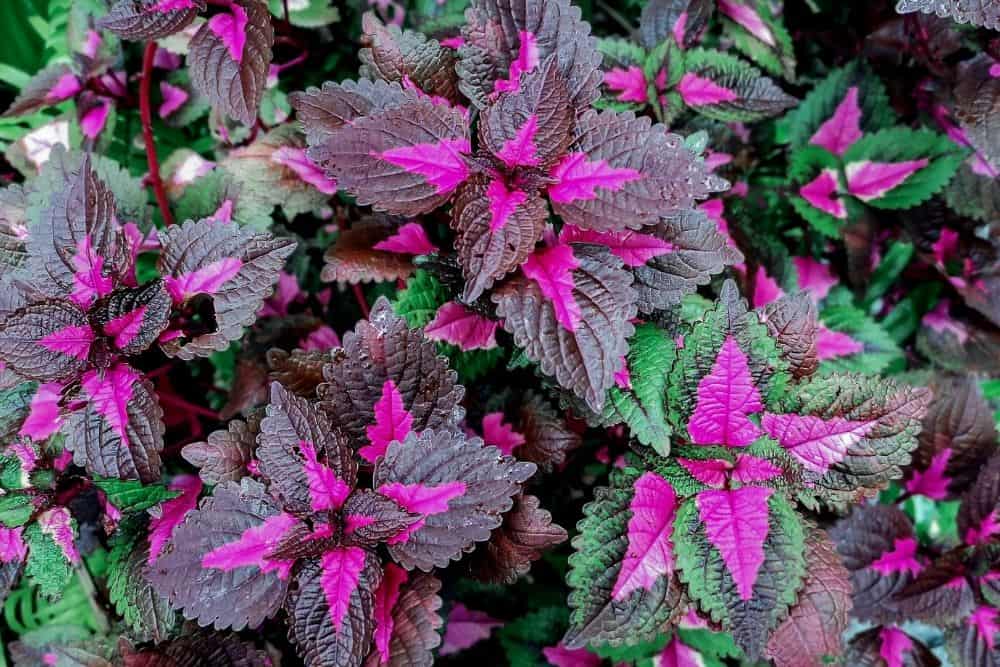
Coleus is a genus of nearly 300 species of plants. Out of these species, the purple variant is a particularly stunning plant that is most commonly grown outdoors, but thrives as an indoor cultivation, too.
The purple plant features dense rich purple leaves that look almost red in the sunlight, with a striking light green outer edge to make the purple even more vivid.
Other purple coleus plants feature a bright splash of light purple, dark purple, or fuschia in the middle of each leaf, so you can choose how purple you want your plant to be.
Due to their stinging nettle-like shape, these plants are often called “painted nettles”.
- Family: Lamiaceae
- Native habitat: Southeast Asia and Australia
- Care: Low to moderate maintenance
- Watering: Once or twice a day in hot months, or as and when
- Soil: Well-draining, high in perlite
- Growth: Up to 36”
- Light: Full sunlight or partial shade
- Humidity: Moderate to high
- Temperature: 70-100 °F
- Common problems: Overwatering leads to root rot
14. Aechmea “Blue Rain” Bromeliad (Aechmea)
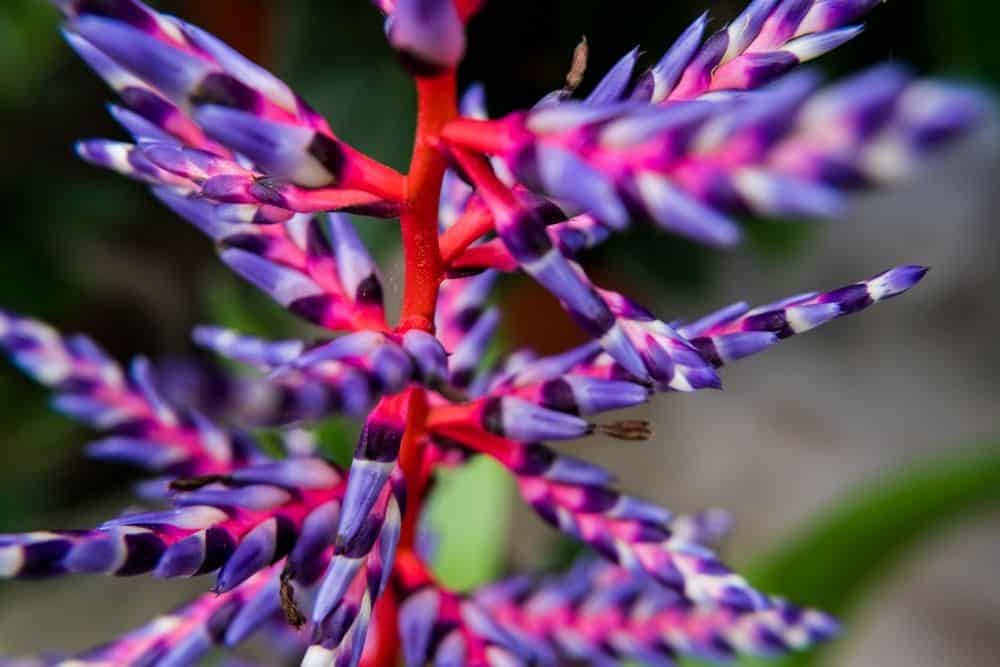
Possibly one of the most extraordinary and lesser known plants on our list, the aechmea “Blue Rain” bromeliad belongs to the bromeliad family, containing roughly 250 species of tropical plants.
While in the wild these plants grow from trees, they can be cultivated indoors if its requirements are met.
The “Blue Rain” hybrid is an astonishing species consisting of vivid violet buds on a bright red stem and central blossoming, allowing the plant to be the center of attention in any room.
Just be aware that, as the name suggests, some “Blue Rain” aechmeas appear more blue than purple!
- Family: Bromeliad
- Native habitat: Mexico, South America, and the Caribbean
- Care: Low-maintenance if requirements are met
- Watering: Prefers moist but not soggy soil
- Soil: Well-draining potting mix
- Growth: Up to 15” tall
- Light: Bright indirect sunlight
- Humidity: High
- Temperature: 65-80 °F
- Common problems: Root rot and bacterial infections from stagnant water
15. Purpurea / Purple Heart (Tradescantia Pallida)
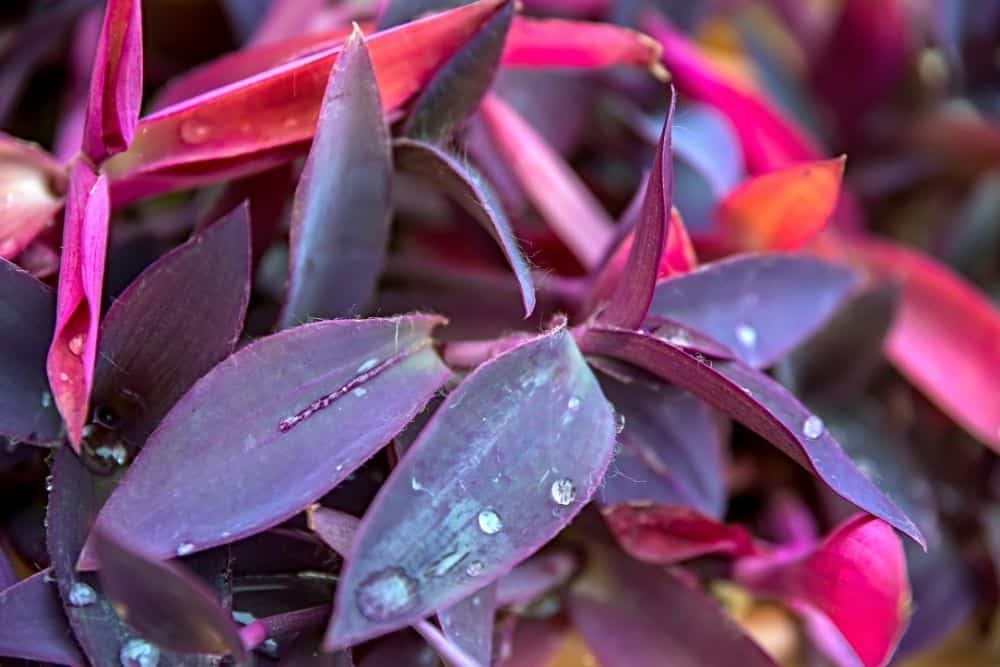
If you’re a fan of flowering purple plants, check out purpurea, also known as “purple heart”. This plant is a species of spiderwort and is aptly named thanks to their distinctive purple stems and bright violet or pink blooms.
The leaves are also the same color as the deep purple stems, making for a striking plant.
While these plants are predominantly cultivated outdoors, they can also be grown indoors if the requirements are met properly.
These flowers are particularly beautiful when grown outdoors to provide a pop of color in a garden.
Just keep in mind that this is a sprawling plant that will grow quite quickly, so it might require some pruning!
- Family: Commelinaceae
- Native habitat: Eastern Mexico
- Care: Moderate maintenance
- Watering: Whenever the soil is dry for indoor cultivation, and more frequently for outdoor cultivation
- Soil: Loamy and neutral
- Growth: Sprawlers, heights of 30-40 cm
- Light: Full sun and partial shade
- Humidity: 40%
- Temperature: Tolerant to drought, fine in most temperatures
- Common problems: Snails and caterpillars when grown outdoors
16. Sweet Potato “Purple” Vine (Ipomoea Batatas)
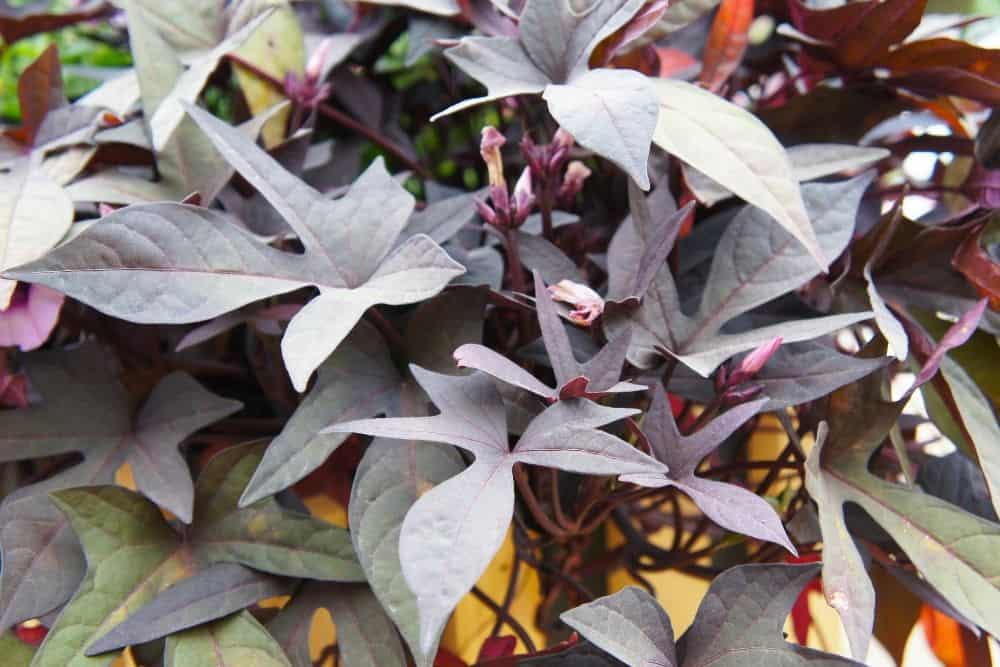
This stunning purple houseplant has a lot of nicknames, including the sweet potato vine, the Sweet Caroline potato vine, and even sweetheart purple.
Sweet potato purple vines are found in a variety of shades, from dark purple to dusty lavender, making for a lovely addition to any exotic indoor or outdoor garden.
The leaves of this plant mimic the shape of ivy leaves, which is why most people will grow it as a “filler” plant in the garden.
Despite this, the intensely purple leaves make the plant a brilliant statement piece in any living area.
- Family: Convolvulaceae
- Native habitat: Tropical America
- Care: Low-maintenance
- Watering: Whenever the soil is dry
- Soil: Any soil
- Growth: 4ft tall
- Light: Partial shade
- Humidity: 40%
- Temperature: 70-80 °F
- Common problems: When grown outdoors, pests like weevils, beetles, aphids, and whitefly are common
17. Purple Waffle Plant (Hemigraphis Alternata)
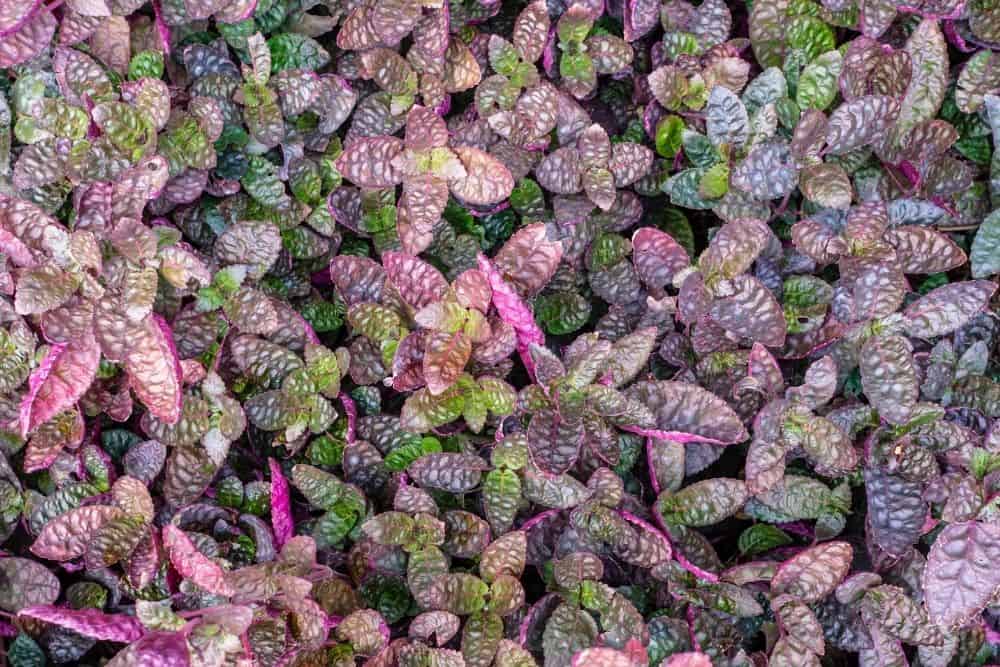
While commonly known as “red ivy”, the purple waffle plant features distinctive dark purple leaves with tones of green or brown.
Due to the mixture of tones, the leaves look somewhat gray and metallic, making for a fascinating addition to the garden or home.
Interestingly, the purple tones appear even brighter when exposed to sunlight, which is why the plant is typically duller in winter.
Apart from its appearance, the reason why the purple waffle plant is so popular is because of its air purifying properties.
This is achieved by the deep puckering in the leaves that increase the leaf’s surface area.
- Family: Acanthaceae
- Native habitat: Java, Asia
- Care: Low-maintenance
- Watering: Regular and whenever necessary
- Soil: Moist and slightly acidic
- Growth: Slow grower with heights of 6”
- Light: Bright and partially shaded indirect sunlight
- Humidity: Likes misting in summer
- Temperature: Over 40 °F
- Common problems: Sensitive to frost
18. Silver Squill (Ledebouria Socialis)
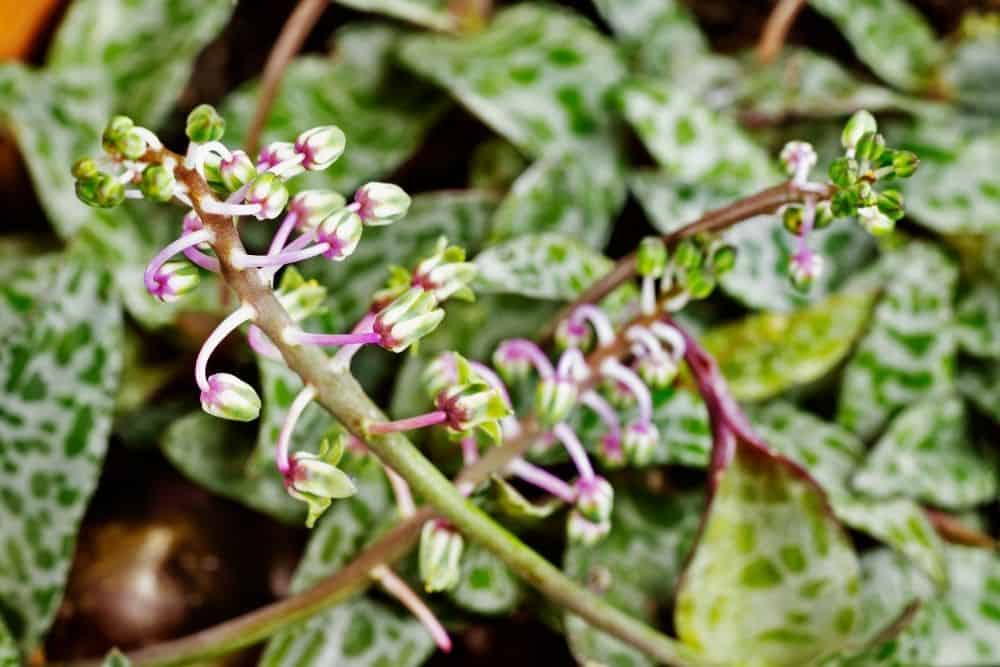
This bulbous perennial plant isn’t the most vividly purple houseplant, but the hues of purple running through the mottled silverish-green leaves earns its place on our list.
While it might be small, this is a tough and resilient species that is ideal for beginners and hobbyists alike.
This is because it has the ability to store moisture in its stems during times of drought, meaning it can thrive off being underwatered.
Plus, you can expect the silver squill to flower during spring and early summer, producing pink stems with small light green flowers.
- Family: Asparagaceae
- Native habitat: South Africa
- Care: Low-maintenance
- Watering: Whenever necessary
- Soil: Well-draining
- Growth: Up to 10” tall
- Light: Shade and indirect sunlight
- Humidity: Low
- Temperature: Cool climates at and below 60 °F
- Common problems: Can be grown outdoors but must be brought indoors during winter
19. Ruby Necklace (Othonna Capensis)
The ruby necklace is a breathtakingly unique succulent that is fast-growing and looks wonderful in indoor hanging baskets.
These plants are fast growers that produce reddish and purple stems and bulbs, which isn’t often commonly found in succulents.
As the name suggests, these bulbs look like gems on a necklace. Plus, it grows all year round!
- Family: Asteraceae
- Native habitat: Eastern Cape of South Africa
- Care: Low-maintenance
- Watering: Whenever necessary
- Soil: Well-draining succulent mix
- Growth: Up to 5-10 cm long
- Light: Shade and indirect sunlight
- Humidity: Low to moderate
- Temperature: Around 60 °F
- Common problems: Don’t water in dormancy period

